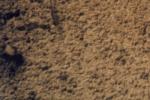
| home | subject | philosophy | people | locations | technology | contact |
|
| |
 |
grenzenlose freiheitinteractive sound installation |
|
| |
|
|
|
|
| |
|
| ||||
|
the approach |
||||
|
|
||||
|
of the »grenzenlose freiheit« is to inscribe sound textures into three different rooms by delegating the particular presentation of the sounds to the audience. thereby the complexity of the sound generation process done by the grinder is hidden by a very simple graphical user interface, the gclient. thus this sound installation can be regarded as a kind of instrument as well as a game, which is enforced by the use of three equivalent handheld computers each showing the state of the others (network game). |
||||
|
| ||||
|
|
||||
|
used hardware |
||||
|
|
||||
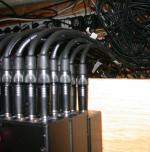
|
|
|||
|
| ||||
|
|
||||
|
the grinder |
||||
|
|
||||
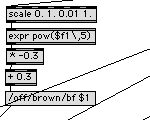
|
the sound engine of the »grenzenlose freiheit« is a slightly modified version of the grinder, a realtime granular synthesis and composing tool developed by gerhard eckel. it has been implemented in the Max/MSP graphical programming language and runs on a Macintosh PowerPC. the sound generation process takes place by stochastically singling more or less small parts out of one or more soundfiles, followed by a signal processing of these parts and, finally, by rendering them via fog synthesis. the final step of the synthesis process is done by the tfog object described below. since fog synthesis is a kind of granular synthesis, the selected parts of the entire soundfile are called grains. each of these grains may be described by several parameters: the underlying soundfile, its starting point within this soundfile, its duration, the temporal distance to the preceding and successing grain, and the channel to which this grain will be sent. due to the ability to manipulate each single grain there are much more parameters, like pitch and level, envelope, reverb level, and several filter methods. by combining and controlling all of these parameters it is possible to create very complex soundscapes. a major principle of the grinder is assigning these parameters stochastically to each of the grains rather than setting these parameters by a certain determinate function. the user of the grinder may set only the basic conditions for this stochastic process as well as the kind of the process, such as brownian movement of parameter values or the selection of values from a given list and following certain selection principles. thus an entire sound situation is characterized by a collection of basic conditions for a stochastic selection process. such a situation could be a very stable one with almost no consequences to the resulting soundscape, it may change over a long period of time, or it may turn quickly into completely disparate sounds. in each case the composition of a soundscape in a particular moment is undetermined and unpredictable while the general character of the development regarded from a higher aesthetical level is well defined. for that reason, soundscapes generated by this technique we call sound textures. several of such sound textures are used in the »grenzenlose freiheit«, which are shared between three grinder engines (berlin version) or groupwise associated which one particular grinder engine (geneva version). each of these textures allows the control of its basic conditions for the stochastic selection process by the visitor: by dragging a graphical representation of the sound event around on the floorplan of the installation and by changing an abstract parameter called "density" which correlates with all of the mentioned parameters above in a certain way. this correlation is done by a so called mapper patch. for each sound texture in our installation a dedicated mapper patch was composed. the collection of these patches together with the underlying soundfiles determine the character of the entire installation and the level of "boundlessness" made available for exploration by the visitor. therefore this set may be considered as a container for the "artistic substance" of the »grenzenlose freiheit«. |
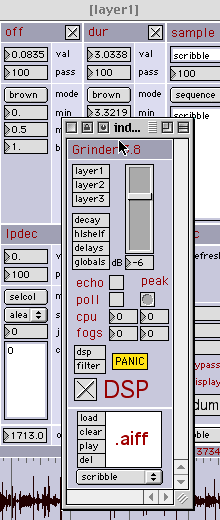
|
||
|
| ||||
|
|
||||
|
the tfog object |
||||
|
|
||||
|
is a Max/MSP external developed by gerhard eckel. it implements a fog generator, which is an extended fof (formant-wave-function) generator using arbitrary soundfiles for the synthesis instead of a sinusoid. the special advantage of the tfog object over other fog generators is its accuracy, which is achieved by using a dedicated scheduler inside the object. due to this technique, calculations are done with a granularity better than sample rate, thus correcting errors which would be otherwise accumulated over time. the fog synthesis technology is described in
|
||||
|
| ||||
|
|
||||
|
the gserver |
||||
|
|
||||
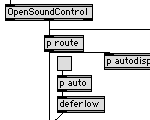
|
is a set of Max/MSP patches written around the grinder sound engine. it provides a thin-layered interface between the grinder and the networked gclients via the osc protocol. the gserver glues the grinder sound engines together with the data (sound material and mapper patches) and allows to startup the whole stuff properly. it receives all the osc messages from the gclients and preprocesses them by routing them to the other gclients and/or forwarding them to the corresponding grinder engine. a simple "auto pilot" is also included in the gserver, mainly for debugging purposes and to jolly the installation along. |
|||
|
| ||||
|
|
||||
|
the gclient |
||||
|
|
||||
|
is the "non-acoustical" interface between the »grenzenlose freiheit« and the visitor. it is a piece of software implementing a graphical user interface (GUI) with the ability of sending and receiving osc messages. the gclient runs on a sharp zaurus SL-5500G handheld computer which itself runs with the free operating system linux. since the graphical environment on the zaurus is based on the free QT library by trolltech, it is possible to write portable applications which run on the zaurus as well. the gclient was developed especially for this sound installation. it provides the GUI representing the floor plan of the location in which the installation takes place and shows the position of the three dragable sound items. the algorithm which causes the speakers to be activated or deactived subject to the position of the corresponding sound item runs inside the gclient as well. thus one can call the »grenzenlose freiheit« a "distributed application". for the sending and receiving of osc messages the libOSC++ (CVS) C++ library is used. the gclient was developed in C++/QT by martin rumori. |
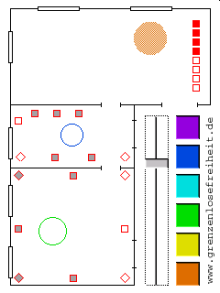 |
|||
|
| ||||
|
|
||||
|
the osc protocol |
||||
|
|
||||
|
osc stands for "OpenSoundControl" and is a thin-layered protocol on top of datagram or stream based network protocols (like UDP or TCP) and the de-facto standard for the exchange of musical data. it was developed by Matt Wright at CNMAT (http://cnmat.berkeley.edu/OSC/). there is a growing number of implementations of the osc protocol for nearly all important hardware and software platforms. osc allows realtime exchange of data across different platforms and is also well suited to be just a structuring element inside a single application. thus the entire grinder engine is divided into several logical layers with different abstraction levels communicating with other levels over osc. this allows reaching the grinder from outside at each of these different levels without the need of especially implementing such an interface. this feature is used in the »grenzenlose freiheit«. for the communication between the gserver and the gclients over the wireless network the following software is used:
|
||||
| top of page | top of page |
|
| ||
|
|
technique (en) -- last modification: 30 Jun 2015 13:16:55 |
disclaimer © 2002-2004 martin rumori |